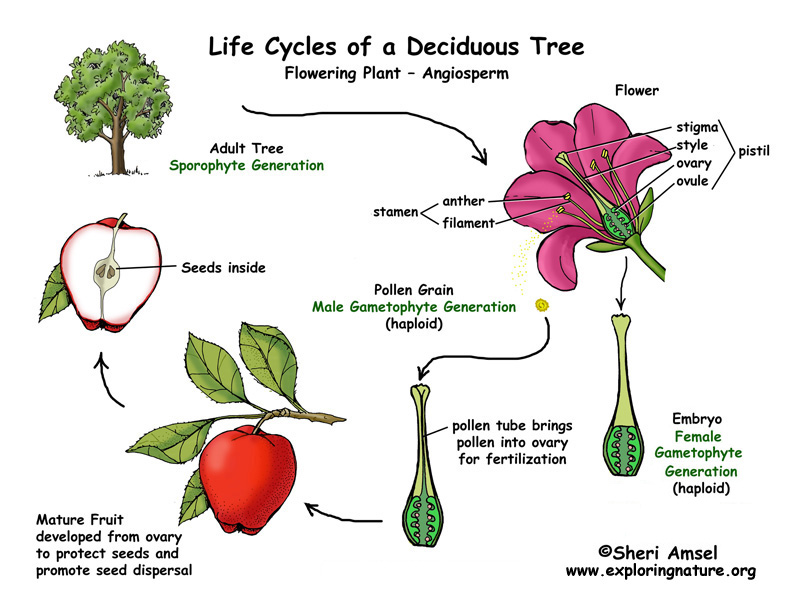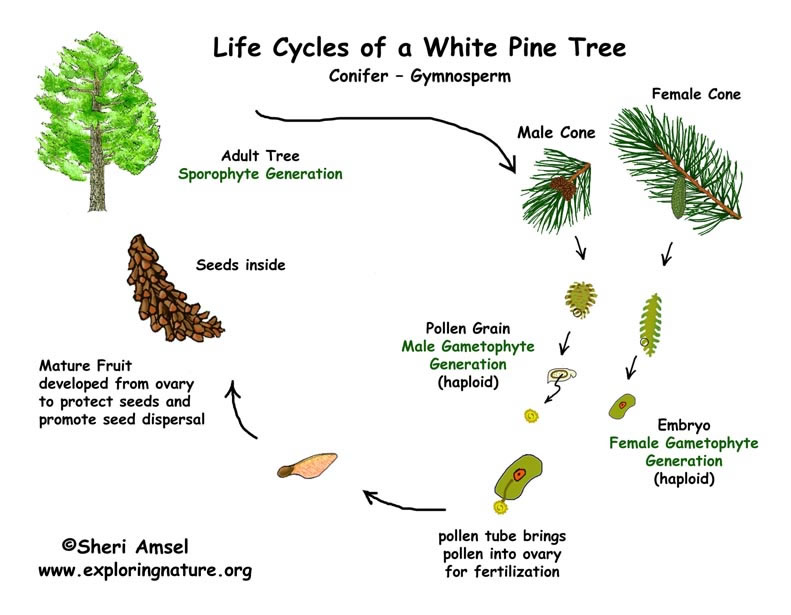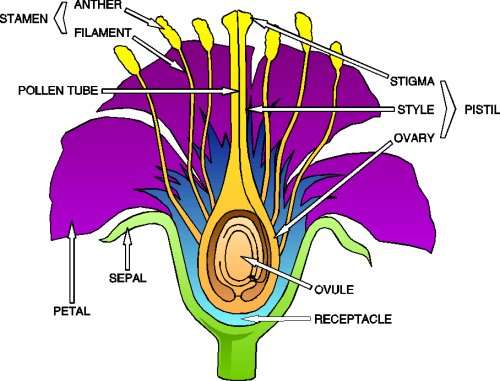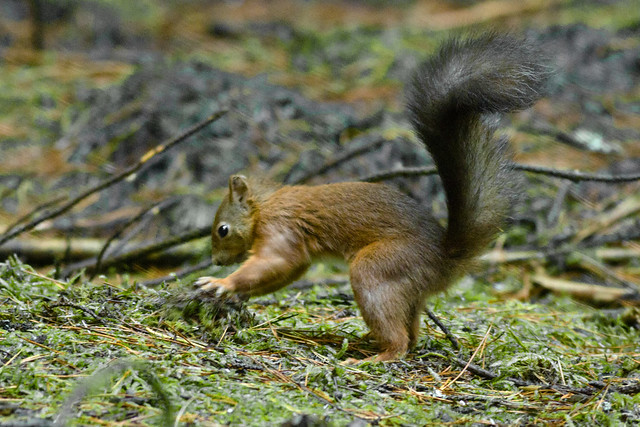Roses are red and violets are blue, I am talking about flowers, to you........ Yes, today we are talking about flowers and it is not even Valentine's Day or Mother's Day. We like how flowers look, we like how flowers smell and we even like giving or getting flowers. But, there is more to flowers than what we see or smell. We are going to learn about the parts of flowers and its function. Also, I am going to talk about my favorite flower and three methods of seed dispersal in plants.
Life Cycle of Angiosperms and Gymnosperms
Angiosperms are flowering seed plants like the apple, plum, cherry, grape or peach. They have seeds which are protected in its fruit. Gymnosperms are the non-flowering seed plants like the cedar, pine and firs trees. Gymnosperms have what you would call "naked seeds." This means that their seeds grow where it can be seen on the upper surfaces of its cone scales.
Angiosperms
All angiosperms are flowering plants which mean that they produce flowers. Flowering plants are not only flowers, but many trees like the apple tree below. Angiosperms seeds are protected inside a fruit.
When the apple tree, or any other flowering plant, opens its flowers, pollen from the male part of the plant is moved by insects, birds or the wind to a female part of the flower. The eggs inside the flower are fertilized by the sperm inside the pollen and produces fruit which has seeds inside. When the fruit ripes and drops to the ground, the seeds can sprout right there. Also, the seeds can be moved to another place by animals that eat the fruit. A new flowering plant will begin to grow where those seeds are dropped. Check out the life cycle of the Apple tree below.
This life cycle begins over and over again! I just never ends!
 |
| The life Cycle of an angiosperm - Apple Tree |
Gymnosperms
The Pine tree below is called a gymnosperm. Unlike an angiosperm its seeds are not inside a fruit. Its seeds are out and attached to a pinecone. When the pollen from a male pine cone floats on the wind it reaches a female pinecone and fertilizes the cone so seeds can grow. When the seeds are ready to grow the pine tree drops the cone to the ground.
An animal, like a squirrel, will take the pinecone apart to eat its seeds and many seeds will fall to the ground. Some may sprout and grow right there. If only one of those seeds grow into a pine tree, the parent tree has been successful.
This life cycle begins over and over again! I just never ends!
 |
| The life Cycle of a gymnosperm - Pine Tree |
Parts of a Flower
The Flower is the reproductive organ of angiosperms. Parts of the flower include petals, sepals, the female reproductive organs, and the male reproductive organs. Petals come in all shapes, sizes and colors and are used to attract insects into the flower. The sepal protect the flower when the flower is growing from a bud and the receptacle attaches the flower to the stalk of the tree.

The Female Reproductive Organs is the Pistil. The pistil is a collective word used for the stigma, style and ovary. Ovules are the female reproductive cells, also known as the eggs. When fertilization takes place, it will become a seed. The style is a tube on top of the ovary that raises the stigma away from the ovary to decrease the chances of pollen contamination. Also, the stigma get the pollen during fertilization. Did you know that the stigma is covered with a sticky substance for pollen to stick to? Finally, the ovary protects the ovule when fertilization has happened.
The Male Reproductive Organs is the Stamen. The Stamen is a collective word for the Anther and the Filament. The anther produces pollen and the filament is the stalk of the Anther. The pollen has male reproductive cells that fertilize the ovules.
My Favorite Flower
Now on to my favorite flower. Most of you have never seen this flower because it only grows in tropical areas. It is the national flower of Saint Lucia and also my Mom's favorite flower. It is called the Red Hibiscus.
This flowering plant is what you would call a big show-off. You can see a hibiscus flowering bush from a distance because of it bright, red, large, beautiful flowers. The flowers are large and shaped like a trumpet with five red petals. This flower is loved by butterflies, bees, and hummingbirds because of its sweet nectar.
Saint Lucians not only enjoys the beauty of the Hibiscus flowers but they also enjoy the tea made from its flowers. Also many Saint Lucians use the crush leaves of the Hibiscus bush as a shampoo to wash their hair. I remember having one of these hibiscus shampoos when I was younger. It was not that I did not have any other shampoo to wash my hair, but my mom likes me to experience everything Saint Lucian. I had remains of leaves stuck in my hair which my mom had to pick out.
 |
| This is the beautiful Red Hibiscus. |
| This a Humming Bird sucking up the sweet nectar from the Red Hibiscus flower. |
Seed Dispersal in Plants
What is seed dispersal? Well, seed dispersal is the transportion of seeds away from the parent plant. Why do plants need to disperse their seed? Well, plants need to disperse their seed away from themselves, to stop overcrowding of plants in one area and to create new plant colonies elsewhere. You see, plants have a limited ability to move that means that they must rely on ways to move their seeds. Plants do not have legs as we do to move from one area to another. That means they have to use methods to disperse their seeds. The three methods of seed dispersion I will talk about are: by wind, by water and by animals.
Animals: Some seeds are animal food. Many seed are dispersed by animals. Take for example the birds who eat berries, travel and pass out the tougher seed which is unharmed in its droppings. Some fruits even have barbs that hooks on to the animal fir or feathers and are carried away. These animals move the seeds from one place to another. Some animals like squirrels bury seeds, like acorns to save for later, but may not return to get the seeds. These seeds can grow into new plants.
 |
| A bird eating berries from a tree. |
 |
| The Black Noddy with Grand Devil's-claws seeds stuck to feathers. |
 |
| A squirrel hiding a pine cone. |
Wind: Some seeds catch the wind. Both small and large seeds can easily be carried by the wind when it blows. Have you ever seen a “helicopter” from the Sycamore tree or a dandelion? What did you notice? The sycamore has “helicopter wings" to carry the seed when a strong wind comes by. I had no idea what these “helicopters” were until I started learning about plants. I would always pick them up and drop it and watch it spin just like the blades of a helicopter. Mother Nature is such a genius. Another example of Mother Nature's Genius is the dandelion seed which have feathery plumes. Have you ever picked a dandelion flower and put it close to your mouth and blew. Did you see how easily the plumes flew apart and away. Well these plumes have seeds which are also flying away and landing in another area.
| A "helicopter" from the Sycamore tree. |
| Plumes from the Dandelion blowing in the wind. |
Water: Some seed use water to catch a ride to their next destination. Many trees that live in or near water have seeds that can float, and are carried by the water. Plants living along streams and rivers produce fruit like the coconut which is water proof and able to float on top of water until it gets to a new place.
| A coconut being carried by the ocean. |
I thought that this was an interesting fun fact. Did you know that the smallest seeds were produced by the Orchid? A single orchid flower produce about 2,000,000 microscopic seeds that drift invisibly in the air. We can't even see these seeds with our naked eyes. That is cool. I wonder how many I have accidentally inhaled.
Thanks for stopping by to check out my latest post. I hope you learned something new. Come back to visit soon. Don' forget to catch one of my flowers before you leave my post.

No comments:
Post a Comment